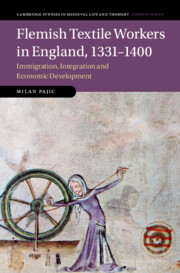Book contents
- Flemish Textile Workers in England, 1331–1400
- Cambridge Studies in Medieval Life and Thought Fourth Series
- Flemish Textile Workers in England, 1331–1400
- Copyright page
- Contents
- Figures
- Maps
- Tables
- Acknowledgements
- Note on Currency, Weights and Measures
- Abbreviations
- Introduction
- Chapter 1 Anglo-Flemish Economic Relations, Complex Urban Revolts and the Politics of Collective Exile in Flanders
- Chapter 2 Flemish and Brabantine Immigrants as Permanent Residents in England 1351–1400
- Chapter 3 Social Relationships and Business Networks of the Flemish Community in England
- Chapter 4 Economic Activities of the Immigrants from the Low Countries: Wool and Woollen Cloth Production and Trade
- Chapter 5 Women from the Low Countries in England and Their Economic Activities
- Chapter 6 Anti-Fleming Sentiment and the Peasants’ Revolt of 1381
- Conclusion
- Book part
- Select Bibliography
- Index
Chapter 5 - Women from the Low Countries in England and Their Economic Activities
Published online by Cambridge University Press: 16 November 2023
- Flemish Textile Workers in England, 1331–1400
- Cambridge Studies in Medieval Life and Thought Fourth Series
- Flemish Textile Workers in England, 1331–1400
- Copyright page
- Contents
- Figures
- Maps
- Tables
- Acknowledgements
- Note on Currency, Weights and Measures
- Abbreviations
- Introduction
- Chapter 1 Anglo-Flemish Economic Relations, Complex Urban Revolts and the Politics of Collective Exile in Flanders
- Chapter 2 Flemish and Brabantine Immigrants as Permanent Residents in England 1351–1400
- Chapter 3 Social Relationships and Business Networks of the Flemish Community in England
- Chapter 4 Economic Activities of the Immigrants from the Low Countries: Wool and Woollen Cloth Production and Trade
- Chapter 5 Women from the Low Countries in England and Their Economic Activities
- Chapter 6 Anti-Fleming Sentiment and the Peasants’ Revolt of 1381
- Conclusion
- Book part
- Select Bibliography
- Index
Summary
Throughout the twelfth and thirteenth centuries, Flemish women had been active in key stages of cloth production, such as weaving, or other finishing crafts (apart from fulling). However, when the textile industry shifted during the fourteenth century towards guild-controlled production of more expensive woollens, job opportunities for women declined. Their involvement as independent workers became rather restricted. They were gradually pushed towards lower-paid, labour-intensive activities in the preparatory stages of cloth production such as washing, combing, carding and spinning the wool. As no scholar on either side of the English Channel has ever considered the position of immigrant women in the fourteenth century, we are left with several open questions: would this shift in production within the urban industries be one of the push factors? How better off were Flemish women if they emigrated to England (alone or with husbands)? The purpose of this chapter is to examine the economic activities of Flemish women in England, with a specific focus on the textile industry and the ways in which women contributed separately from their male compatriots.
- Type
- Chapter
- Information
- Flemish Textile Workers in England, 1331–1400Immigration, Integration and Economic Development, pp. 211 - 239Publisher: Cambridge University PressPrint publication year: 2023

